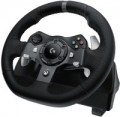Number of buttons
The total number of buttons provided in the design of the manipulator.
The more buttons — the more additional features you can "tie" to the manipulator, the lower the likelihood that during the game you will have to turn to other controls (for example, a PC keyboard). However, many game consoles (see "Platform Compatibility") provide a certain minimum number of buttons for a compatible gamepad — a smaller number simply would not allow full use of all the functions of the console. For example, the original PlayStation 4 controller has 11 buttons.
Note that the D-Pad (see below) is not included in this calculation: it is considered a specific control, although it is based on buttons.
Steering wheel turn
The angle of rotation of the steering wheel in the manipulator-steering wheel (see "Device type"). This parameter is measured over a general range — from one extreme point to another; accordingly, the angle of rotation from the middle position will be half the total. For example, a figure of 180° means that the steering wheel is capable of turning to the right and left by 90°.
Both the general level and the purpose of the steering wheel directly depend on this parameter. Models with a rotation angle of up to 270° are predominantly entry-level and are intended mainly for fans of arcade racing without much emphasis on realism, as well as for children and novice gamers. In more advanced rudders, the steering angle is already
900 °, or even 1080 °. These numbers are taken for a reason — they correspond to the steering wheel ranges in most production cars (900 °), as well as some sports supercars (1080 °). Thus, such characteristics make the use of the steering wheel as realistic as possible — on the other hand, they significantly affect the cost.
The steering wheel rotation range can be adjusted by the
steering wheel angle adjustment function (if such a feature is implemented in the game controller). The option is configured either directly in the game, or through the software that controls the operation of the steering wheel.
Steering material
The material from which the steering wheel itself is made in manipulators of the corresponding type (see "Device type").
Note that the basis of the steering wheel is traditionally plastic. Therefore, this parameter is indicated by the material of the outer surface of the steering wheel: it is with this surface that the user's hands are in contact, it is she who is primarily responsible for the appearance of the device and the general impression of its use.
— Rubber. Rubber coating is relatively inexpensive, while it is quite convenient and practical. So, due to its softness and elasticity, such a surface is pleasant to the touch, at the same time it looks quite authentic — similar materials are often used in steering wheels of real cars. Therefore, it is this option that is most popular nowadays. Of the disadvantages of rubber, one can note only poor scratch resistance, but this is a common feature of many fairly advanced steering wheel materials.
— Plastic. Steering wheel made entirely of plastic; the outer coating may differ somewhat from the base, however, both belong to the same class of materials. The key advantage of this option is low cost; in addition, plastic can be made sufficiently resistant to scratches, scuffs and other damage. On the other hand, the plastic surface is somewhat less comfortable than the same rubber, and it does not always look solid and reliable enough. In addition, smooth plastic tends to slip in the hands...(although embossed protrusions or other similar solutions may be provided to compensate for this disadvantage). Therefore, this material is used less often, mainly in relatively inexpensive steering wheels (although there may be exceptions using high-quality plastic grades).
— Leather. The cover is made of artificial, occasionally — genuine leather. These materials belong to the premium class: they have a stylish appearance, are pleasant to the touch, but they also cost accordingly. However a leather substitute can be both high-class and relatively inexpensive — however, in the latter case, there is no need to talk about durability and durability; natural leather, in turn, is by definition quite expensive. On the other hand, such coatings provide maximum authenticity — to the point that the controller "smells like a real steering wheel, and not like a plastic toy."
— Alcantara. A material also known as "faux suede". In fact, it is a variety of the leather (imitation leather) described above, however, it stands out in a separate category, as it has specific features — primarily a characteristic velvety surface. Thanks to this, this material is pleasant to the touch, while it looks great and at the same time is quite durable and practical; It is worth saying that Alcantara is widely used in the decoration and external tuning of real cars, including luxury cars. At the same time, the cost of such a finish, including for game steering wheels, turns out to be considerable; therefore, only some high-end models are made from Alcantara.
Pedals
Types of pedals supplied with the manipulator.
This parameter is indicated only in controllers designed for auto racing (in flight simulators, pedals have only one specialization — rudder — and there is no need to specify it additionally). Most of these "racing" controllers are handlebars (see Device type), but pedals can also be produced completely separately. Anyway, the minimum necessary for more or less efficient driving is two pedals, gas and brake. At the same time, for lovers of maximum realism, more expensive
three-pedal controllers are being produced that also include a clutch; this complicates the control, but gives many additional features that are not available on two pedals.

